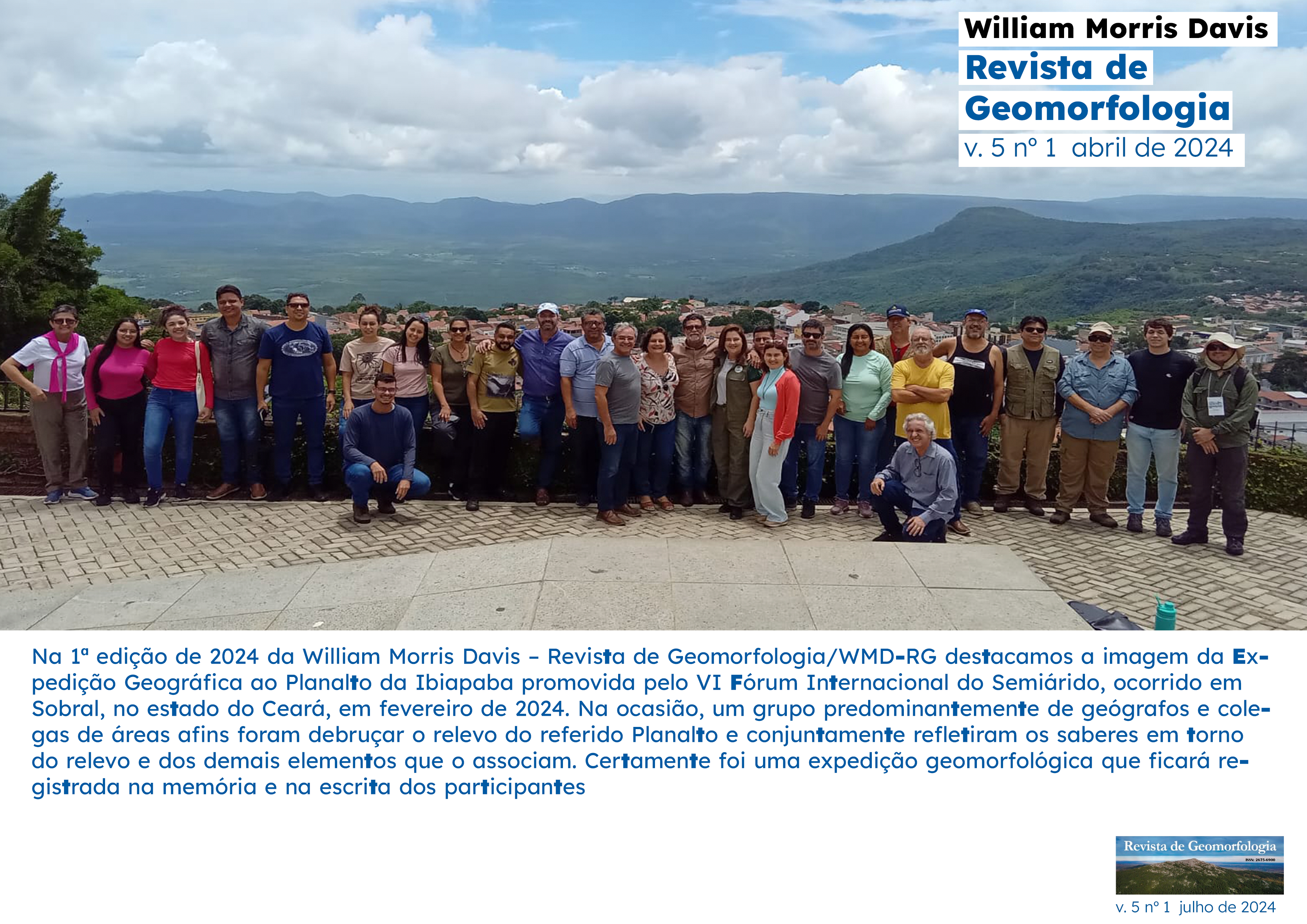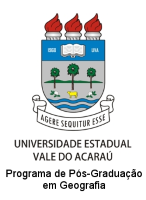MORPHOLOGICAL, PHYSICAL AND CHEMICAL CHARACTERIZATION OF A YELLOW Oxisol, IN THE BRAZILIAN SEMI-ARID / CARACTERIZAÇÃO MORFOLÓGICA, FÍSICA E QUÍMICA DE UM LATOSSOLO AMARELO, NO SEMIÁRIDO BRASILEIRO
DOI:
https://doi.org/10.48025/ISSN2675-6900.v5n1.2024.608Keywords:
Pedogeomorphology, Caatinga, Structure, DystrophicAbstract
The Brazilian semi-arid region is marked by incipient pedogenesis, a low degree of chemical weathering and low leaching, however, some semi-arid environments have antagonistic landscapes and environmental conditions, as is the case of places with Oxisols associated with the Serra do Sedimentary Formation. Martins. There are few works that offer a discussion with the generation of primary data on the properties of Oxisols in the Brazilian semi-arid region. The objective of this work was to carry out a morphological, physical and chemical characterization of a Yellow Oxisol, in the Brazilian semi-arid region, with more specifically the RPPN Olho d’água das Onças, in Picuí-PB, as the study area. Analyzes were carried out in the office, field and laboratory. The soil was classified according to SiBCS. Physical and chemical analyzes were carried out following EMBRAPA procedures. The analyzed soil presents a predominance of coarse sand in all horizons, with contents varying from 0.58 to 0.70 kg.kg. The silt/clay ratio varied between 0.54 and 0.62. All horizons were classified as sandy loam. The Yellow Oxisol was classified as endhalic, that is, it has aluminum saturation (m) ≥ 50% in the Bw1 and Bw2 horizons. pH values ranged from 4.97 to 5.23 and organic matter ranged from 1.98 to 4.28%. From the results of this work, it can be concluded that the Brazilian semi-arid region is very diverse, and there are environments that can present very chemically weathered and leached soils, such as those found in sedimentary areas with table relief. In these sectors, there are soils with morphological, chemical and physical characteristics similar to those found on coastal tablelands. In these specific areas, environments are formed where the evolution of the soil is closely associated with the characteristics of the relief, which is why it can be associated with pedogeomorphological evolution.
References
ANGELIM, L.A.A.; et al. Geologia e Recursos Minerais do Estado Do Rio Grande Do Norte. Recife: CPRM - Serviço Geológico do Brasil, 2006.
CAMPOS, M. C. C. et al. Relações solo-paisagem em uma litossequência arenito-basalto na região de Pereira Barreto, SP. Rev. Bras. Ciênc. Solo, v. 31, n. 3, p. 519-529, 2007. Disponível em: https://www.scielo.br/j/rbcs/a/GMYyCkfT9hvJW8fRkpckLWm/. Acesso em: 31 mar. 2023.
BOCKHEIM, J.G.; GENNADIYEV, A.N., Hammer, R.D. & Tandarich, J.P. (2005) Historical development of key concepts in pedology. Geoderma, 124: 23-36.
DUARTE, R. M. R; CASAGRANDE, J. C. Interação do solo–vegetação na recuperação de áreas degradadas. BARBOSA, LM Manual para recuperação de áreas degradadas em matas ciliares do Estado de São Paulo. São Paulo: Instituto de Botânica, p. 60-77, 2006.
GUERRA, A. J. T. Novo Dicionário Geológico-Geomorfológico. 6. ed. Rio de Janeiro: Bertrand Brasil, 2008.
GIONGO,Vanderlise; ANGELOTTI, Francislene. Agricultura de baixa emissão de carbono em regiões semiáridas: experiência brasileira. Editoras técnicas. – Brasília, DF :
Embrapa, 2022, p. 256. ISBN 978-65-89957-12-6
Instituto Brasileiro de Geografia e Estatística – IBGE. Manual técnico de pedologia: guia prático de campo / IBGE, Coordenação de Recursos Naturais e Estudos Ambientais. – Rio de Janeiro: IBGE, 2015. p.134.
JACOMINE, P. K. T.; et al. Levantamento exploratório de reconhecimento de solos do Estado do Rio Grande do Norte. Recife: DNPEA: Sudene, 1971. 531 p. (DNPEA. Boletim técnico, 21; SUDENE. Pedológia, 9)
MEIRELES, H. T. et al. Relações solo-paisagem em topossequência de origem basáltica. Pesq. Agropec. Trop., Goiânia, v. 42, n. 2, p. 129-136, abr./jun., 2012. Disponível em: https://www.scielo.br/j/pat/a/3zZPLTgMcn8XtYZSzNymsJt/?format=pdf&lang=pt. Acesso em: 4 fev. 2023.
MACHADO, D. F. T; CASTRO, S. S.; LADEIRA, F. S B. A Geopedologia como abordagem metodológica para o levantamento de solos: uma breve discussão. Revista Brasileira de Geomorfologia. 2022, p. 1835-1857.
MUNSËLL. Soil Color Charts. Maryland, 1994.
NETTO, A. M., et al.Caracterização hidrodinâmica e hidrodispersiva de um latossolo amarelo na microrregião do brejo paraibano. R. Bras. Ci. Solo, p.86-96, 2012.
PHILLIPS, D. H. et al. Soil-landscape relationships at the lower reaches of a watershed at Bear Creek near Oak Ridge, Tennessee. Catena, v. 44, n. 3, p. 205- 222, 2001. Disponível em: https://www.sciencedirect.com/science/article/abs/pii/S0341816200001569. Acesso em: 4 abr. 2023.
REIS, M. S. et al. Variações da composição granulométrica e orgânica do solo em uma topossequência da microrregião de Marabá-PA. Boletim do Museu Paraense Emílio Goeldi Ciências Naturais, Belém, v.2, n.3, p.33-44, dez. 2007. Disponível em: http://scielo.iec.gov.br/scielo.php?script=sci_arttext&pid=S198181142007000300004. Acesso em: 2 mar. 2023.
RIBEIRO, L.P. Os Latossolos Amarelos do Recôncavo Baiano; gênese, evolução e degradação. Salvador : SEPLANTEC, CADCT, 1998.
ROCHA, D. F. A pedogeomorfologia em ambiente semiárido paraibano, Brasil. Dissertação de Mestrado, Universidade Federal do Rio Grande do Norte, Centro de Ensino Superior do Seridó, Programa de Pós-Graduação em Geografia, Caicó, RN, 2023, p.93.
SANTOS et al. Interações pedogeomorfológicas na Bacia Hidrográfica do Rio Piranhas-Açu, no semiárido brasileiro. Revista Brasileira de Geografia Física, v.16, n.04, 2023, p. 1776-1792.
SANTOS, H.G., et al. Sistema brasileiro de classificação de solos.5. ed., rev. e ampl. − Brasília, DF: Embrapa, 2018. p. 356.
SANTOS, E.J.; FERREIRA, C.A.; SILVA JR., J.M.F. Geologia e Recursos Minerais do Estado da Parnaíba. Recife: CPRM - Serviço Geológico do Brasil, 2002.
SANTOS, A. S., LIRA, D. I., COSTA, T. S. B., ROCHA, D. F., LOPES, D. V. Interações pedogeomorfológicas na Bacia Hidrográfica do Rio Piranhas-Açu, no semiárido brasileiro. Revista Brasileira de Geografia Física. v.16, n.04 (2023) 1776-1792.
SILVA, Í. B, NASCIMENTO, R. S; MONTEIRO, E. S. O município de Picuí – PB na ótica da Desertificação. Cadernos de Agroecologia. Resumos do VII Congresso Brasileiro de Agroecologia. Fortaleza/CE, 2011, p.6. SILVA, Ícaro Guedes et al. GEOSCIENCE AND ENVIRONMENTAL EDUCATION IN THE BRAZILIAN SEMIARID REGION: A CASE STUDY IN THE PRIVATE RESERVE OF NATURAL HERITAGE OLHO D'ÁGUA DAS ONÇAS. International Journal Semiarid, v. 5, n. 5, 2022.
SOUZA, J.J.L.L., CASTRO, F.E.C., ANDRADE, C.V.P.A., KER, J.C., PEREZ FILHO, A. Brazilian semiarid soils formed during the last glacial maximum. Catena 223, 2023, 106899. https://doi.org/10.1016/j.catena.2022.106899
SOUZA, D.V., et al. Relict soil features in cave sediments record periods of wet climate and dense vegetation over the last 100 kyr in a 1792resente-day semiarid region of northeast Brazil. Catena 226, 2023. 107092. http://dx.doi.org/10.1016/j.catena.2023.107092
SANTOS, E.J.; FERREIRA, C.A.; SILVA JR., J.M.F. Geologia e Recursos Minerais do Estado da Parnaíba. Recife: CPRM - Serviço Geológico do Brasil, 2002, p.142.
SANTOS, H.G., et al. Sistema brasileiro de classificação de solos.5. ed., rev. e ampl. − Brasília, DF: Embrapa, 2018. p. 356.
SOUZA, J. J. L. L.; et al. Archaeoanthrosol formation in the Brazilian semiarid. Catena, v. 193, p. 104603, 2020.
SOUZA, J.J.L.L. et al. Tropical forest refuge in peripheral soils of slags in Caatinga. Bio Rxiv, 2018. https://doi.org/10.1101/317685.
SOUZA, J.J.L.L.; et al. Organic carbon rich-soils in the brazilian semiarid region and paleoenvironmental implications. Catena, 212, 2022. https://doi.org/10.1016/j.catena.2022.106101.
SOUZA, J.J.L.L., CASTRO, F.E.C., ANDRADE, C.V.P.A., KER, J.C., PEREZ FILHO, A. Brazilian semiarid soils formed during the last glacial maximum. Catena 223 (2023) 106899, 2023. https://doi.org/10.1016/j.catena.2022.106899.
TEIXEIRA, P. C.; DONAGEMMA, G. K.; FONTANA, A.; TEIXEIRA, W. G. (Ed.). Manual de métodos de análise de solo. 3. ed. rev. e ampl. Brasília, DF: Embrapa, 2017, p.573.
ZINCK, J. A. Geopedologia: elementos de geomorfología para estúdios de suelos yde riesgos naturales. ITC: Faculty of Geo-information Science and Earth Observation. Enscheade, The Netherlands, 2012, p. 232.
Downloads
Published
How to Cite
Issue
Section
License
Copyright (c) 2024 ÍCARO GUEDES DA SILVA, DANIELMA FERREIRA DA ROCHA, DAVÍ DO VALE LOPES, JOSÉ JOÃO LELIS LEAL DE SOUZA

This work is licensed under a Creative Commons Attribution 4.0 International License.
This work is licensed under a Creative Commons Attribution 4.0 International License.
Autores que publicam nesta revista concordam com os seguintes termos:
- Autores mantém os direitos autorais e concedem a William Morris Davis o direito de primeira publicação, com o trabalho simultaneamente licenciado sob a Creative Commons Attribution License (CC-BY 4.0), que permite o compartilhamento do trabalho com reconhecimento da autoria do trabalho e publicação inicial nesta revista.
- Autores têm autorização para assumir contratos adicionais separadamente, para distribuição não-exclusiva da versão do trabalho publicada nesta revista (ex.: publicar em repositório institucional ou como capítulo de livro), com reconhecimento de autoria e publicação inicial nesta revista.
- Autores têm permissão e são estimulados a publicar e distribuir seu trabalho online (ex.: em repositórios institucionais ou na sua página pessoal) após o processo editorial, já que isso pode aumentar o impacto e a citação do trabalho publicado (Veja O Efeito do Acesso Livre).
- Autores são responsáveis pelo conteúdo constante no manuscrito publicado na revista.







